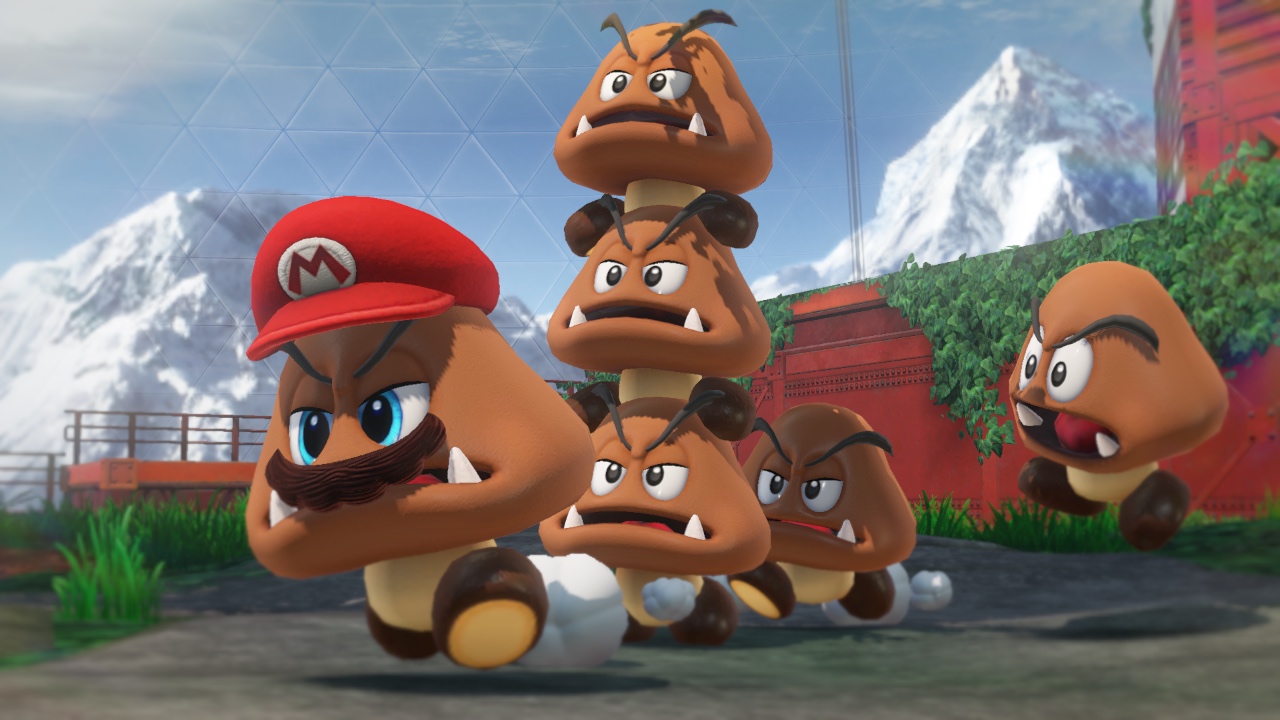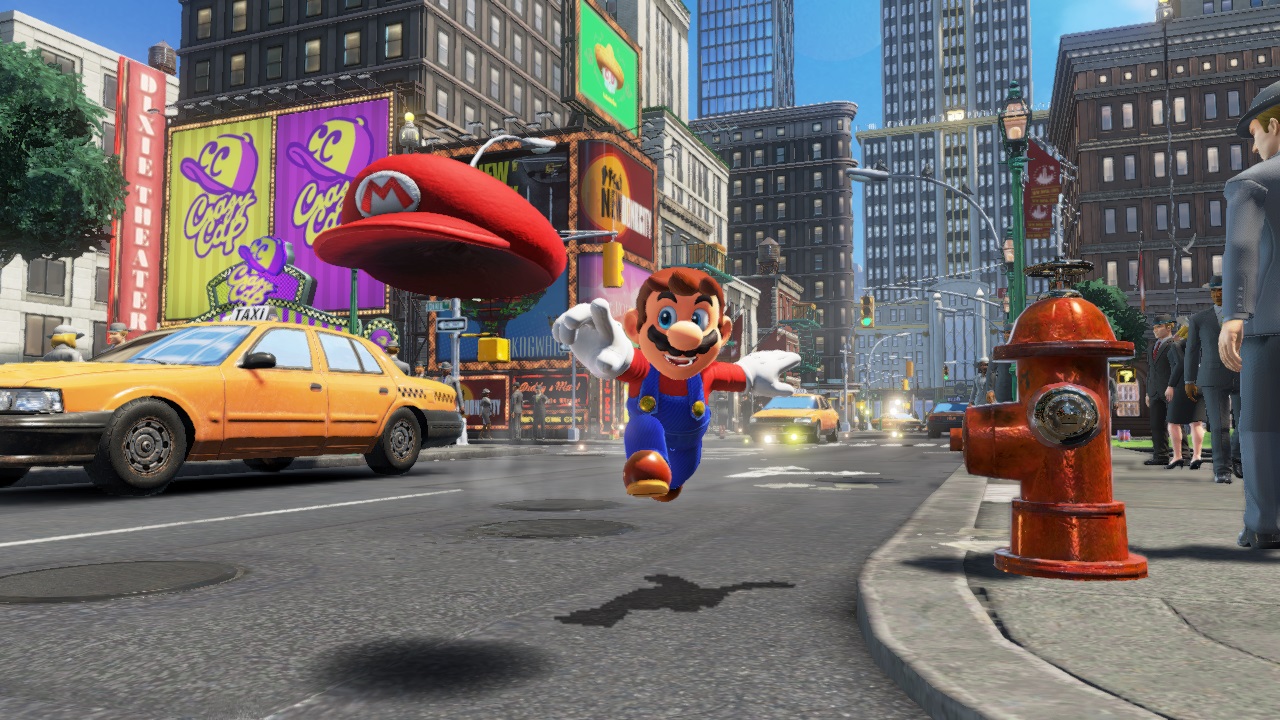Bowser and his crew of henchman have once again abducted Princess Peach, leaving it up to Mario to traverse various worlds — stomping down on all sorts of villains along the way — in order to save her. Stop me if you’ve heard this one before. After watching Super Mario Odyssey’s opening act, you’d be forgiven for expecting the game to feel like so many of the heroic Italian plumber’s other platform-hopping adventures.
That couldn’t be further from the truth.
Super Mario Odyssey, launching for the Nintendo Switch on Oct. 27, is Nintendo’s grandest reimagining of the Super Mario series in years. The sandbox-style title is the franchise’s first open-world game since Super Mario Sunshine hit the GameCube back in 2002. And Nintendo’s first Mario game in this style, 1996’s Super Mario 64, wasn’t just a best-seller — it laid the groundwork for how 3D console games should look and feel.
Of course, plenty has changed in the gaming world in the 15-year gap between Sunshine and Odyssey. Back in 2002, Sunshine’s sun-bathed Delfino Island offered a more expansive gameplay environment than Super Mario players were used to exploring. Odyssey takes that concept even further. “Players who come to this game are going to find that they have a lot more to play with,” says Super Mario Odyssey director Kenta Motokura. “There’s a very great density of gameplay elements packed into this world.”
Super Mario Odyssey gets its name from the airship that Mario and his newfound companion, the aptly-named Cappy, use to trek between kingdoms. The game begins with longtime Mario nemesis Bowser storming the skies above Princess Peach’s castle with his massive ship, kidnapping her and forcing her to marry him. After enduring a thrashing from Bowser that sends him flying into the distance, Mario wakes up in an unfamiliar world known as Cap Kingdom. That’s where Mario meets Cappy, the magical sidekick that inhabits his signature red cap, and the audience learns that Bowser has also kidnapped Cappy’s sister. The player’s main objective throughout the game is to collect Power Moons to juice up the Odyssey so that Mario and Cappy can catch Bowser.

Read more: 30 Ultimate Tech Gifts for Every Person on Your Holiday Shopping List
Odyssey manages to turn the Super Mario series upside down while staying true to the franchise’s most beloved qualities — and dialing them up to 11. For instance: Mario has long been able to gain new powers throughout a game. Over the course of his 34-year life, he’s plucked fiery flowers that enable him to hurl flames at foes, he’s dressed in penguin costumes that help him coast along icy surfaces, and he’s donned cat suits that allow him to scale the sides of walls. Cappy makes all that seem tame by comparison. He helps Mario fully transform into different adversaries and other fixtures found throughout the game, ranging from pint-sized Goombas to miniature tanks capable of firing explosives and power lines that make it possible cover long distances in a quick zap. Just tossing Cappy at either of these characters or elements will do the trick.
From the start, Nintendo knew that assuming the powers of Mario’s assailants would be an important part of Odyssey. Since the game was being developed in conjunction with the new Nintendo Switch, the notion of flicking the console’s Joy-Con controllers to trigger that capture action seemed like a natural fit. These two concepts — the capture system and Joy-Con flicking gesture — led to the creation of Cappy.
“We were looking for a way to give the player a lot of different abilities that would be fun to use,” says Motokura. “The idea that allowed us to tie all of these together was this capture mechanic.”
Cappy has plenty of ways to help Mario aside from transmogrification, too. Shaking the controller downward prompts Cappy to roll like a wheel, which can be useful for knocking out multiple attackers at once. For times in which players may find themselves surrounded and outnumbered, they can snap the Joy-Cons to one side to make Cappy surround Mario in a circle, wiping out foes along the way. And he’s a vital helper in Mario’s trademark airborne antics. When there’s a platform that seems to be just out of Mario’s reach, pressing and holding the Y button will suspend Cappy in midair, providing a middle ground that Mario can hop on to reach his goal. Finding hidden surprises in Odyssey can often involve some combination of traditional wall jumping and Cappy’s special skills. There are so many ways to control Cappy that Nintendo opted to make him his own separate playable character in the two-player version of Odyssey.
“Since we knew we had the character of Cappy, we could do something different with multiplayer,” says Yoshiaki Koizumi, the game’s producer. “Not parallel roles like Mario and Luigi, but slightly separated functional roles that Mario and Cappy could be working on different kinds of actions for each player.”

Giving gamers the opportunity to play as enemies in a flagship Super Mario title also required the development teams to rethink the way they create levels for Super Mario Odyssey. Each kingdom is littered with puzzles that can only be solved when Mario uses Cappy to jump into the body of one of his foes. Colossal stones that obstruct your path must be demolished by a Chain Chomp’s razor sharp teeth. The only way to reach the Power Moon sitting atop an isolated pillar in the desert is by hitching a ride via Bullet Bill. And how else would you be able to retrieve the Power Moon shards scattered at the bottom of the Lake Kingdom without swimming like a Cheep Cheep? The mechanism changes the dynamic between the player and these characters. At times, Mario relies on their help so much that it can come as a relief to encounter these enemies, whereas many were once obstacles to overcome.
With this in mind, the Odyssey team approached level design from two different perspectives. From one standpoint, they would look at individual characters and decide what type of environment would be most fun for controlling that character. And conversely, there were times in which they thought about the level first and then brainstormed ideas for characters who would best suit that setting.
“Previously, if you think about traditional level design, you would create a stage and you would lay out enemies on them at certain locations,” says Motokura. “But this time around you are becoming one of them. And then the interest becomes traversing the level. And so a lot of the traditional ideas that we might have had from this level design theory weren’t necessarily usable as-is, but just gave us the opportunity to come up with completely new solutions.”
Read more: You Can Now Hack the SNES Classic to Add More Games

Discovery has always been at the heart of Super Mario games, and that holds true for Odyssey. Travel is a prevalent theme throughout the game, affecting everything from the game’s plot to Mario’s outfits and even the game’s currency. Special coins that can only be spent in specific kingdoms are hidden throughout various stages. This currency often unlocks special costumes and hats that match that world’s theme, such as a snorkeling goggles in the Lake Kingdom and a safari exploration outfit in the wooded kingdom. The map Mario and Cappy refer to when traveling between worlds aboard the Odyssey lays out the various kingdoms like stops on a train. Some stages bear more similarities to the real world than that of any past Mario game, such as Metro Kingdom’s New Donk City, which includes more realistic portrayals of people.
“We thought it would be really fun if Mario appeared in a place that you were familiar with,” says Motokura. “In trying various [prototype stages], we realized that Mario is such a strong character that no matter where he appears, it still feels like a Mario game.”
Super Mario Odyssey is further proof that Mario is genre-agnostic: he can hop between open worlds, side-scrolling platformers, and mobile running games with ease. Whether Mario will revisit other previously seen genres or appear in completely new game categories anytime soon is still uncertain. But Nintendo isn’t putting any limits on Mario’s potential. “Certainly Mario has had lots of different jobs in the past,” says Koizumi. “And I think that there are many roles yet that he may still fulfill.”
More Must-Reads from TIME
- Donald Trump Is TIME's 2024 Person of the Year
- Why We Chose Trump as Person of the Year
- Is Intermittent Fasting Good or Bad for You?
- The 100 Must-Read Books of 2024
- The 20 Best Christmas TV Episodes
- Column: If Optimism Feels Ridiculous Now, Try Hope
- The Future of Climate Action Is Trade Policy
- Merle Bombardieri Is Helping People Make the Baby Decision
Contact us at letters@time.com